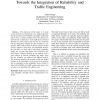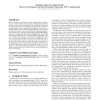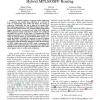104
Voted
CN
2007
15 years 15 days ago
2007
As traffic on the Internet continues to grow exponentially, there is a real need to solve scalability and traffic engineering simultaneously — specifically, without using over-p...
COMCOM
2004
15 years 17 days ago
2004
We demonstrate the benefits of traffic engineering by studying three realistic network models derived from an actual service provider network. We evaluate traffic engineering in t...
109
Voted
WSC
2004
15 years 2 months ago
2004
As the Internet grows, traffic engineering has become a widely-used technique to control the flow of packets. For the inter-domain routing, traffic engineering relies on configura...
104
click to vote
CIC
2006
15 years 2 months ago
2006
The main goal of this paper is to make a step towards the development of a unified approach that incorporates both reliability and traffic engineering aspects into a common, unifie...
111
Voted
NETWORKING
2008
15 years 2 months ago
2008
There have been research initiatives in centralized control recently, which advocate that the control of an autonomous system (AS) should be performed in a centralized fashion. In ...
110
Voted
NETWORKING
2008
15 years 2 months ago
2008
In this paper we present an intelligent multi-topology IGP (MT-IGP) based intra-domain traffic engineering (TE) scheme that is able to handle unexpected traffic fluctuations with n...
107
Voted
EENERGY
2010
15 years 4 months ago
2010
Energy consumption of the Internet is already substantial and it is likely to increase as operators deploy faster equipment to handle popular bandwidthintensive services, such as ...
135
click to vote
GLOBECOM
2009
IEEE
15 years 4 months ago
2009
IEEE
A common objective of Internet traffic engineering is to minimize the maximal link utilization in a network in order to accommodate more traffic and reduce the chance of congestion...
118
Voted
ICC
2007
IEEE
15 years 4 months ago
2007
IEEE
This paper reports on a promising approach for solving problems found when Multi Protocol Label Switching (MPLS), soon to be a dominant protocol, is used in core network systems. D...
124
click to vote
GLOBECOM
2007
IEEE
15 years 4 months ago
2007
IEEE
Open Shortest Path First (OSPF) is one of the most widely used intra-domain routing protocol. It is well known that OSPF protocol does not provide flexibility in terms of packet fo...



